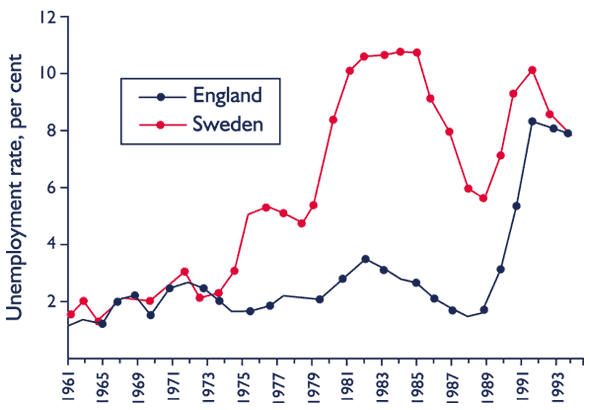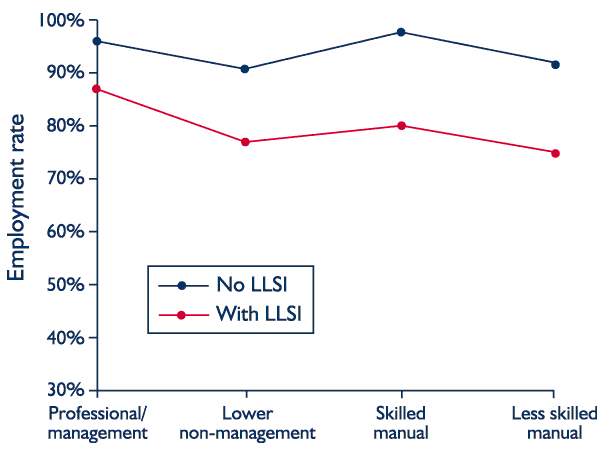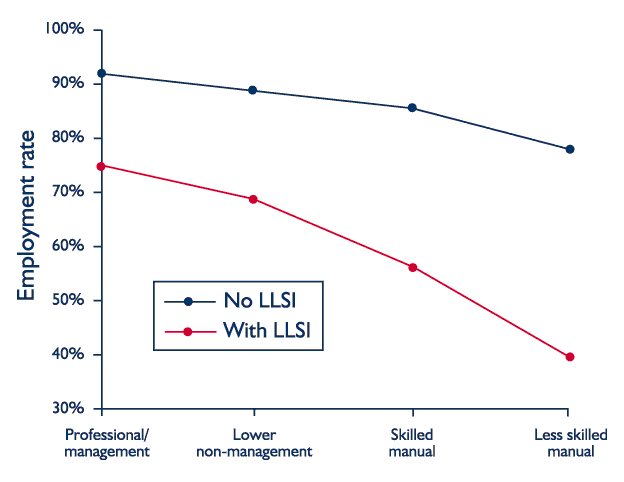 |
Close
window to return
|
Issue 4, July 1999, pp.12-14.
Longterm
illness: studying social consequences and policy impacts
Bo Burström, Margaret Whitehead and Finn Diderichsen
Background to the
project
This Anglo-Swedish project, co-funded by the ESRC Health Variations Programme
and by Swedish research grants, has the overall aim of exploring the impact
of social welfare policies on inequalities in health in Britain and Sweden.
A cross-country comparison was designed to make use of 'natural policy
experiments' in which contrasting policies were being pursued in the two
countries as they sought to deal with changing patterns of employment
and family life. Two population groups were selected for whom the functioning
of the social welfare system was considered particularly important: lone
parents and people at risk of and experiencing unemployment. This article
focuses on one of our studies of people at risk of unemployment and focuses
on how people with chronic illness fare in the two countries.
Dropping out of employment
Unemployment is a serious problem for many industrialised countries, and
has been for the past 20 years. There has been a rising trend in the number
of people unemployed in the countries of the OECD - remaining fairly stable
at around 10 million from 1950 to 1974, but then increasing dramatically
after the first oil crisis in 1974 and again after the second crisis in
1979, to stand at more than 30 million by the mid-1990s.(1) The level
has remained stubbornly high in many countries, and has not settled back
to its original level after each peak. Within the industrialised world,
European countries have been hardest hit: the unemployment rate in the
EU has risen from less than 3% in the early 1970s to around 11% by the
mid-1990s.(2) The European Commission acknowledges that 'unemployment
remains the major economic and social problem confronting the Union.'(3)
Because the rise in unemployment is linked to the collapse in demand for
unskilled labour across the industrialised world, the effect has been
much greater in the industrial sector and has hit manual workers with
less skill and education the most.(4) At the same time, economic inactivity
among men of working age has been rising across Europe, adding to the
proportion of men who are not in employment for one reason or another.
Neither Sweden nor Britain has escaped the influence of these macro-economic
developments. Both have experienced increases in male economic inactivity
and both have seen unemployment rise, though in different periods (see
Figure 1).
Figure 1: Unemployment rate, population aged 16 years and over, England
and Sweden 1961-1995

In Sweden unemployment
rates have traditionally been very low in comparison with other Western
countries ever since World War II. At the end of the 1980s, workforce
participation rates were at their highest. The economic crisis at the
beginning of the 1990s, however, interrupted this favourable long-term
trend and unemployment rates increased sharply from less than 2% to over
8%, accompanied by a 10% reduction in total employment.(5) In Britain,
a rapid growth in unemployment was experienced between 1979 to 1985, followed
by a fall and then another peak in 1991, before starting to decline again
after 1993.(6)
The fate of people with chronic illness
It could be predicted that these adverse trends would hit people with
chronic illness even harder, as they are likely to fare badly compared
to healthier workers in any competition to get and to keep jobs. Mel Bartley
and Charlie Owen have shown that this is indeed the case in Britain. Furthermore,
they concluded that socio-economic status makes a large difference to
the impact of illness on the ability to remain in paid employment, and
that this impact increases as unemployment rises.7
Policy influences
How people with chronic illness fare in the labour market depends on several
factors, including macro-economic developments, but also on labour and
social policy measures which may vary between countries.
Sweden has one of the most regulated labour markets in Europe: Britain
has one of the least regulated. In addition, Sweden has launched active
retraining and rehabilitation programmes to help unemployed people with
chronic illnesses get back to work, as a part of its commitment to state
support and welfare provision. Retraining and rehabilitation are seen
as one potential way in which the health sector can help to tackle the
continuing rise in the proportion of the population classed as permanently
sick.
In recent years, there has been a two-way traffic between Britain and
Sweden in ideas and political debate about possible policy solutions to
these pressing problems. British policy-makers have been attracted to
Sweden's regulated labour market and associated social and health policies,
seeing them as providing greater security of employment for older workers
and for people with chronic illness. In turn, some Swedish commentators
have been attracted to Britain's more flexible, deregulated labour market,
seeing it as offering better employment opportunities for unskilled workers
and for those with chronic illness. Two contrasting hypotheses may be
formulated in this context:
1. that the more flexible, deregulated labour market in Britain would
result in higher employment rates than in Sweden, for those with and without
limiting long- standing illness;
2. that, because of active labour market measures and associated policies,
people with limiting long-standing illness would have a stronger attachment
to the labour market in Sweden than in Britain, even during periods of
reduced demand for labour.
Figure 2: Employment rates among men aged 25-29 years with and without
limiting longstanding illness (LLSI), by socio-economic group, Sweden
1992-1995

Studying social
consequences and policy impacts
To explore these hypotheses, we compared the social consequences in terms
of attachment to the labour market (employment, unemployment and economic
inactivity rates) among people with and without limiting long-standing
illness in different socio-economic groups in Britain and Sweden during
the period 1979-1995. Empirical analysis of the British General Household
Survey (GHS) and the Swedish Survey of Living Conditions (ULF) was carried
out, together with an assessment of the Swedish policy experiments on
rehabilitation carried out in the 1990s and their potential role in helping
different groups back into work. As the patterns and policy impacts were
likely to differ by gender, separate analyses were carried out for women
and for men.
Figure 3: Employment rates among men aged 25-29 years with and
without limiting longstanding illness (LLSI), by socio-economic group,
Britain 1992-1995

Figures 2 and 3 illustrate
some of our findings in relation to employment for men with and without
limiting longstanding illness (LLSI), during the early 1990s when the
overall unemployment rates were at similar levels in the two countries.
During this period, Sweden had higher levels of employment than Britain
for both healthy and sick men. Furthermore, the figures illustrate that
Sweden had smaller socio-economic differentials in employment rates than
Britain: ranging from 87% of Swedish men with LLSI in professional and
managerial occupations to 75% for less skilled manual workers. In comparison,
the differential in employment rates for British men with LLSI ranged
from 75% for professionals and managers to 40% for less skilled manual
workers.
Conclusions
These and further findings from our study lend no support to the first
hypothesis: there would appear to be no benefit for Sweden in copying
British de-regulation policies in terms of opportunities for people with
LLSI to get and to keep jobs. In relation to the second hypothesis, we
then asked what had the Swedish policy experiments on rehabilitation to
offer in terms of lessons for Britain and other countries? We are currently
exploring this issue and our evaluations of these experiments indicate
both positive and negative impacts, and highlight above all the importance
of taking account of the wider macro-economic and policy context in which
specific initiatives take place.
Bo Burström and Finn Diderichsen are based at the Department of
Public Health Sciences, Karolinska Institute, Stockholm.
Margaret Whitehead was based at the King's Fund, London for the duration
of this project and is now Professor of Public Health at the Department
of Public Health, University of Liverpool.
References:
1. OECD (1994) The OECD Jobs Study, Paris : Organisation of Economic
Co-operation and Development.
2. Martin, R. (1998) 'Regional dimensions of Europe's unemployment crisis'
in P. Lawless, R. Martin and S. Hardy (eds.) Unemployment and Social
Exclusion: Regional Policy and Development 13, London : Regional Studies
Association.
3. European Commission (1995) Employment in Europe, Luxembourg
: European Commission.
4. Nickell, S. and Bell, B. (1995) 'The collapse in demand for the unskilled
and unemployment across the OECD' in A. Glyn and K. Mayhew (eds.) Oxford
Review of Economic Policy, II (I) Unemployment pp.40-62.
5. Statistical Yearbook of Sweden (1995) Stockholm : Statistiska centralbyran,
1994.
6. Office for National Statistics (various years) Regional Trends,
London : The Stationery Office.
7. Bartley, M. and Owen, C. (1997) 'Relation between socio-economic status,
employment, and health during economic change, 1973-1993' British Medical
Journal, 313 pp.445-449.